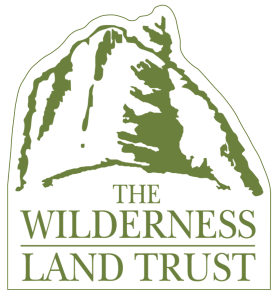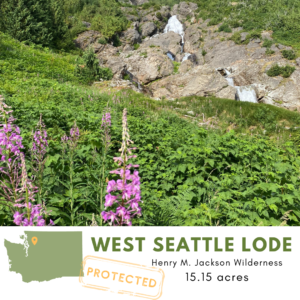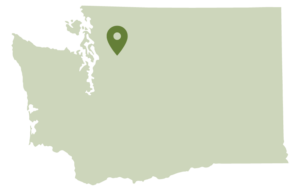Protecting public access
February 24, 2023- It is not an uncommon story across the West for access to public lands through private property to be withdrawn by the private landowner. In many cases the agreements between landowners and federal or state agencies to allow public access date back decades and were established with a handshake rather than a legal easement. So, as properties change hands, passed down through a family or sold, attitudes about allowing the public on trails or along rivers can shift. In some cases this has led to trail systems being closed, shutting hikers out of a whole section of National Forest.
Of course, as property owners, it is their right to decide how their land is used and who has access to it. So, one of the best solutions for ensuring continued public access is to work with willing sellers to purchase the property and transfer it to public ownership to be incorporated into the wilderness area. Through the years the Trust has protected public access across private inholding in this way throughout the West. Recently, projects in Colorado’s Weminuche Wilderness and Mount Massive Wilderness and Oregon’s Hells Canyon Wilderness protected popular trails, and a project in the Castle Crags Wilderness of California opened up access for climbers to a new part of the wilderness area.
Public access is just one of the characteristics of wilderness we work to protect. But for anyone who can remember their first time reaching a wilderness boundary sign on a trail or their first time seeing the night sky shining more brightly than ever before, you how powerful these experiences in wild places can be. There are people who believe wilderness is important and should be protected who have never stepped foot in it. But to experience it for yourself and form your own relationship with it is the best way to become an advocate for it. We believe that wilderness is for everyone: whether you’ve been going there your whole life or are going there for the first time; whether your family has a generations long connection with it or you are the first generation to experience it; whether you’re an expert at hiking, camping, fishing, hunting, paddling, or horse packing, or you’re a beginner. So as we work to protect public access in wilderness across the West, it truly is for everyone.




 Located in the Bodie Hills, just east of Yosemite National Park, the property stretches across five parcels, dispersed throughout a large ranch holding.
Located in the Bodie Hills, just east of Yosemite National Park, the property stretches across five parcels, dispersed throughout a large ranch holding.


 In the San Jan Mountains of Colorado, southeast of the small town of Silverton, the Weminuche Wilderness covers almost half a million acres of pristine alpine habitat, including three 14,000 ft peaks. We recently completed the purchase of three parcels known as the Great Western Lode, totaling 30.96 acres. Protected within the property is a fragile community of grasses, sedges, and dwarf plants that make up Colorado’s alpine tundra. The popular 9.3 mile
In the San Jan Mountains of Colorado, southeast of the small town of Silverton, the Weminuche Wilderness covers almost half a million acres of pristine alpine habitat, including three 14,000 ft peaks. We recently completed the purchase of three parcels known as the Great Western Lode, totaling 30.96 acres. Protected within the property is a fragile community of grasses, sedges, and dwarf plants that make up Colorado’s alpine tundra. The popular 9.3 mile  The Trust recently completed the purchase of the 15.15-acre West Seattle Lode, our first acquisition in Washington’s Henry M. Jackson Wilderness. This rugged, glaciated landscape is home to the endangered Northern Spotted Owl, Cascade red fox, pika, wolverines, and Marbled Murrelet, a seabird that nests in old growth forests and alpine slopes. The property is on a steep slope that overlooks the Monte Cristo ghost town, the site of a gold and silver mining boom lasting from 1895-1912.
The Trust recently completed the purchase of the 15.15-acre West Seattle Lode, our first acquisition in Washington’s Henry M. Jackson Wilderness. This rugged, glaciated landscape is home to the endangered Northern Spotted Owl, Cascade red fox, pika, wolverines, and Marbled Murrelet, a seabird that nests in old growth forests and alpine slopes. The property is on a steep slope that overlooks the Monte Cristo ghost town, the site of a gold and silver mining boom lasting from 1895-1912. The 20-acre Jasperson Lode property was purchased by The Trust in 2017, and was recently transferred to public ownership. This newest addition to the Wild Sky Wilderness sits in a bowl on the south flank of the imposing Sheep Gap Mountain, just west of the Silver Creek drainage. With the property now incorporated into the wilderness, the patchwork of land management regulations and wildlife habitat has been removed, ensuring seamless conservation across the landscape.
The 20-acre Jasperson Lode property was purchased by The Trust in 2017, and was recently transferred to public ownership. This newest addition to the Wild Sky Wilderness sits in a bowl on the south flank of the imposing Sheep Gap Mountain, just west of the Silver Creek drainage. With the property now incorporated into the wilderness, the patchwork of land management regulations and wildlife habitat has been removed, ensuring seamless conservation across the landscape.



 November 3, 2022- This week the Wilderness Land Trust completed the purchase of the privately owned 280-acre Greater New York Lode property in Washington’s Wild Sky Wilderness.
November 3, 2022- This week the Wilderness Land Trust completed the purchase of the privately owned 280-acre Greater New York Lode property in Washington’s Wild Sky Wilderness.



